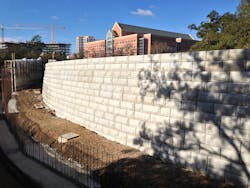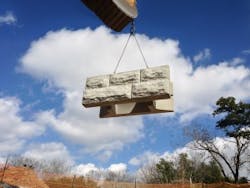Retaining Wall Blocks Show Advantages Over Cast-in-Place Walls
Editor’s note: This article first appeared in the June 2015 edition of Erosion Control.
Houston Zoo features retaining wall blocks are strong enough to withstand a gorilla.
Just as the citizens of San Juan Capistrano, CA, eagerly await the annual return of the swallows, residents of Houston, TX, have been anxious for gorillas to be back at the downtown Houston Zoo. It’s been 10 years since the zoo has had gorillas in residence for people to enjoy watching.
When the gorillas move back into the Houston Zoo this year they will enjoy a fabulous new home. Their $29 million section is part of the African Forest exhibit, which was created by the celebrated zoo design firm The Portico Group of Seattle, WA. The general contractor for the project is Bellows Construction Co. of Houston.
The unique Gorillas of the African Forest exhibit lets zoo visitors see the animals on three levels, as if they were in the midst of a real African forest. At the highest level, visitors are at eye level with the gorillas as they play in the tree tops.
Just like its real-world counterpart, the exhibit has a waterfall and stream, natural logs, and lots of trees. All parts of the exhibit had to be secure, to keep the gorillas safely within it and prevent any chance of their escaping. That degree of security called for a retaining wall 20 feet tall.
The wall, which totals just over 200 feet, was built in the first phase of the exhibit’s construction, in 2012. It took about a month to finish and three months in all for other parts of the infrastructure, says Ray Mancias, vice president at Bellows Construction Co.
The close proximity of a 100-year-old live oak tree, which the zoo staff wanted to keep, meant that a tieback wall could not be built. A much better option—the one selected for the project—was a gravity wall composed of precast concrete retaining wall blocks from Stone Strong Systems of Texas.
This wall could be built for about 20–30% less cost and in half the time that a cast-in-place wall would require. The retaining wall blocks’ built-in drainage system would be a significant advantage, given Houston’s humid climate and annual rainfall of 50 inches.
“There were days with lots of rain, but it wasn’t too bad,” says Mancias. “When you’re doing an outside project like this one, Mother Nature is your biggest challenge.”
Stone Strong’s Chiseled Granite pattern was selected for the retaining wall blocks that would compose the wall. Each block is 8 feet long, 3 feet tall, and 44 inches deep, with a 4-inch setback every 3 feet.
Weight was an important consideration, because an adult gorilla can lift up to 4,000 pounds. Anything lighter in this exhibit would have to be anchored to the ground. The Stone Strong blocks weigh 6,000 pounds each.
“The ascent of the wall goes a lot faster than you may anticipate, so long as you have gravel there to fill in and the crew onsite to do the earthwork. You can lay a lot of block in a day,” explains Mancias.
The concrete block crew consisted of five men. The earthwork crew had another six or seven members. Four men worked on drainage. Mancias says that the crews worked in sequence with each other carefully, which made the work go faster.
Wall construction had to be done while the zoo remained open to visitors. There wasn’t room to store the concrete blocks onsite, so they were trucked in, offloaded with a front-end loader, and lifted directly into place.
Coordinating casting and delivery times was challenging. So was positioning of the blocks, as vertical elevation had to be held within a variation of no more than 1 inch.
Mancias says that the hardest part of the project was managing “the sequence of backfilling behind the wall to stabilize it. We set the concrete blocks, then filled in with gravel, then backfilled with dirt.”
Surprising aspects of the project were “just the topography and the small site we had to work with. It was filled with equipment and materials.”



